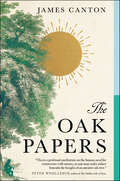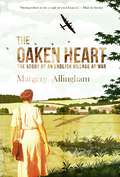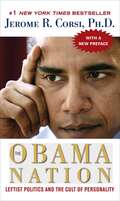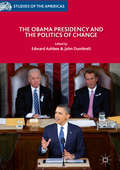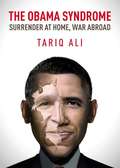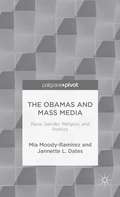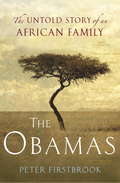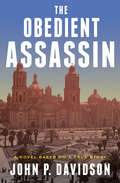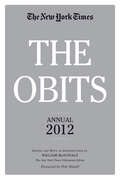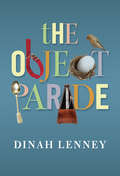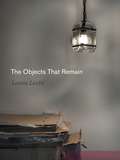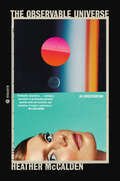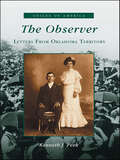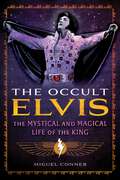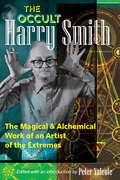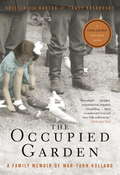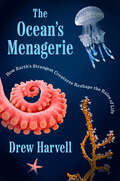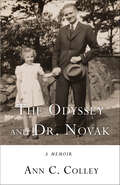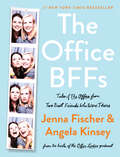- Table View
- List View
The Oak Papers
by James Canton"A profound meditation on the human need for connection with nature, as one man seeks solace beneath the bows of an ancient oak tree."—Peter Wohlleben, author of The Hidden Life of Trees"James Canton knows so much, writes so well and understands so deeply about the true forest magic and the important place these trees have in it. Knowledge and joy."— Sara Maitland, author of How to Be AloneJoining the ranks of The Hidden Life of Trees and H is for Hawk, an evocative memoir and ode to one of the most majestic living things on earth—the oak tree—probing the mysteries of nature and the healing role it plays in our lives.Thrown into turmoil by the end of his long-term relationship, Professor James Canton spent two years meditating [PA1]beneath the welcoming shelter of the massive 800-year-old Honywood Oak tree in North Essex, England. While considering the direction of his own life, he began to contemplate the existence of this colossus tree. Standing in England for centuries, the oak would have been a sapling when the Magna Carta was signed in 1215.In this beautiful, transportive book, Canton tells the story of this tree in its ecological, spiritual, literary, and historical contexts, using it as a prism to see his own life and human history. The Oak Papers is a reflection on change and transformation, and the role nature has played in sustaining and redeeming us. Canton examines our long-standing dependency on the oak, and how that has developed and morphed into myth and legend. We no longer need these sturdy trees to build our houses and boats, to fuel our fires, or to grind their acorns into flour in times of famine. What purpose, then, do they serve in our world today? Are these miracles of nature no longer necessary to our lives? What can they offer us? Taking inspiration from the literary world—Henry David Thoreau, Leo Tolstoy, Katherine Basford’s Green Man, Thomas Hardy, William Shakespeare, and others—Canton ponders the wondrous magic of nature and the threats its faces, from human development to climate change, implores us to act as responsible stewards to conserve what is precious, and reminds us of the lessons we can learn from the world around us, if only we slow down enough to listen.
The Oaken Heart: The Story of an English Village at War
by Margery AllinghamWorld War II on the home front: &“Fans of The Guernsey Literary and Potato Peel Pie Society or James Herriot will enjoy this unique historical account.&” —Library Journal This remarkable firsthand account—from the acclaimed Golden Age mystery author—was written to let people know how the Second World War affected ordinary English country people. The Oaken Heart is Margery Allingham&’s tribute to the resiliency and determination of the people of Tolleshunt D&’Arcy, the Essex village where she lived and nicknamed &“Auburn&” in her manuscript. Allingham, already a successful mystery author in 1939, was at work on the Albert Campion novel Traitor&’s Purse. The first hint of war was felt in the alarm of a radio announcer&’s voice, and Allingham put down her pen as her peaceful corner of the world braced for sending its men into battle, and even possible invasion. As villagers rallied around the cause—supporting each other and their country—Allingham found herself acting as the local billeting officer and first aid organizer. She writes of the sacrifices of farmers, the mistrust of politics, the grim acceptance of rationing, the bombing of London. And through it all, the never-ending hope for peace. The Oaken Heart captures the personal and universal toll of war, far from the front lines, written by a woman whose own quest for justice jumped from the page to the streets where she lived. &“Engrossing and moving.&” —Kirkus Reviews &“Her record of the events and people of this fraught wartime period is rendered with the skill found in the best of her fictional writing . . . remains an insight into another facet of a remarkable talent.&” —Crime Time
The Obama Nation: Leftist Politics and the Cult of Personality
by Jerome R. CorsiIn this thoroughly researched and documented book, the #1 New York Times bestselling co-author of Unfit for Command: Swift Boat Veterans Speak Out Against John Kerry explains why the extreme leftism of an Obama presidency would leave the United States weakened, diminished and divided, why Obama must be defeated -- and how he can be. Barack Obama stepped onto the national political stage when the then-Illinois State senator addressed the 2004 Democratic National Convention. Soon after Obama was elected to the U. S. Senate, author Jerome Corsi began researching Obama's personal and political background. Scrupulously sourced with more than 600 footnotes, The Obama Nation is the result of that research. By tracing Obama's career and influences from his early years in Hawaii and Indonesia, the beginnings of his political career in Chicago, his voting record in the Illinois legislature, his religious training and his adoption of Christianity through to his recent involvement in Kenyan politics, his political advisors and fundraising associates and his meteoric campaign for president, Jerome Corsi shows that an Obama presidency would, in his words, be "a repeat of the failed extremist politics that have characterized and plagued Democratic Party politics since the late 1960s. "In this stunning and comprehensive new book, the reader will learn about: Obama's extensive connections with Islam and radical politics, from his father and step-father's Islamic backgrounds, to his Communist and socialist mentors in Hawaii and Chicago, to his long-term and close associations with former Weather Underground heroes William Ayers and Bernadette Dohrn -- associations much closer than heretofore revealed by the press. Barack and Michelle's 20-year-long religious affiliation with the black-liberation theology of former Trinity United Church of Christ Reverend Jeremiah Wright, whose sermons have always been steeped in a rage first expressed by Franz Fanon , Stokely Carmichael and Malcolm X, a rage that Corsi shows has deep meaning for Obama. Obama's continuing connections with Kenya, the homeland of his father, through his support for the candidacy of Raila Odinga, the radical socialist presidential contender who came to power amid Islamist violence and church burnings. Obama's involvement in the slum-landlord empire of the Chicago political fixer Tony Rezko, who helped to bankroll Obama's initial campaigns and to purchase of Barack and Michelle's dream-home property. The background and techniques of the Obama campaign's cult of personality, including the derivation of the words "hope" and change." Obama's far-left domestic policy, his controversial votes on abortion, his history of opposition to the Second Amendment, his determination to raise capital-gains taxes, his impractical plan to achieve universal health care, and his radical plan to tax Americans to fund a global-poverty-reduction program. Obama's naïve, anti-war, anti-nuclear foreign-policy, predicated on the reduction of the military, the eradication of nuclear weapons and an overconfidence in the power of his personality, as if belief in change alone could somehow transform international politics, achieve nuclear-weapons disarmament and withdrawal from Iraq without adverse consequences, for us, for the Iraqis or for Israel. Meticulously researched and documented, The Obama Nation is the definitive source for information on why and how Barack Obama must be defeated -- not by invective and general attacks, but by detailed arguments that are well-researched and fact-based.
The Obama Presidency and the Politics of Change
by Edward Ashbee John DumbrellThis edited volume considers the extent to which the Obama presidency matched the promises of hope and change that were held out in the 2008 election. Contributors assess the character of "change" and, within this context, survey the extent to which there was enduring change within particular policy areas, both domestic and foreign. The authors combine empirical detail with more speculative assessment of the limits and possibilities of change amidst a very dense institutional landscape and in an era of intense political polarization. Some see significant changes, the full consequences of which may only be evident in later years. Other authors in the collection present a markedly different picture and suggest that processes of change were not only limited and partial but at times leading the US in directions far removed from the promises of 2008. The book will make an important contribution to the debates about the Obama legacy.
The Obama Syndrome: Surrender at Home, War Abroad
by Tariq Ali"In Cairo, at West Point, at Oslo, Obama has treated the world to one uplifting homily after another, each address larded with every euphemism that White House speechwriters can muster to describe America's glowing mission in the world: 'Our country has borne a special burden in global affairs'; 'Our cause is just, our resolve unwavering. ' The model for this variant of imperial presidency is Woodrow Wilson-no less pious a Christian, whose every second word was peace, democracy or self-determination, while his armies invaded Mexico, occupied Haiti and attacked Russia. But can't still goes a long way to satisfy those who yearn for it. . . " Book jacket.
The Obamas And Mass Media
by Mia Moody-Ramirez Jannette L. DatesUsing the cultural prism of race, this book critically examines the image of African Americans in media of the twenty-first century. Further, the authors assess the ways in which media focused on gender, religion, and politics in framing perceptions of the President and First Lady of the United States during the Obama administration.
The Obamas: The Untold Story of an African Family
by Peter FirstbrookOn January 20, 2009, a few hundred men, women, and children gathered under trees in the twilight at K#x19;obama, a village on the shores of Lake Victoria in western Kenya. Barack Obama#x19;s rise to the American presidency had captivated people around the world, but members of this gathering took a special pride in the swearing in of America#x19;s first black president, for they were all Obamas, all the president#x19;s direct African family. In the first in-depth history of the Obama family, Peter Firstbrook recounts a journey that starts in a mud hut by the White Nile and ends seven centuries later in the White House. Interweaving oral history and tribal lore, interviews with Obama family members and other Kenyans, the writings of Kenyan historians, and original genealogical research, Firstbrook sets the fascinating story of the president#x19;s family against the background of Kenya#x19;s rich culture and complex history. He tells the story of farmers and fishermen, of healers and hunters, of families lost and found, establishing for the first time the early ancestry of the Obamas. From the tribe#x19;s cradleland in southern Sudan, he follows the family generation by generation, tracing the paths of the famous Luo warriors-Obama#x19;s direct ancestors-and vividly illuminating Luo politics, society, and traditions. Firstbrook also brings to life the impact of English colonization in Africa through the eyes of President Obama#x19;s grandfather Onyango. An ambitious and disciplined man who fought in two world wars, witnessed the bloody Mau Mau insurrection, and saw his country gain independence from white rule, Onyango was also hot-tempered and autocratic: family lore has it that President Obama#x19;s grandmother abandoned the family after Onyango attempted to murder her. And Firstbrook delves into the troubled life of Obama#x19;s father, a promising young man whose aspirations were stymied by post-independence tribal politics and a rash tendency toward self-destruction-two factors that his family believes contributed to his death in 1982. They say it was no accident, as described in the president#x19;s memoirs, but rather a politically motivated hit job. More than a tale of love and war, hardship and hard-won success, The Obamas reveals a family history-epic in scope yet intimate in feel-that is truly without precedent.
The Obedient Assassin: A Novel Based on a True Story
by John P. DavidsonA dark and riveting thriller that reimagines the life and mission of the Spanish nationalist enlisted to murder Leon Trotsky: Based on a true chapter of world history and ten years of research, here is the story of the real-life reluctant soldier and killer, Ramón Mercader—the obedient assassinRamón Mercader was plucked from the front of the Spanish Civil War by the Soviets and conscripted to murder the great intellectual Leon Trotsky, a leader of the Bolshevik Revolution who was exiled in the 1920s for opposing Joseph Stalin.As Ramón is trained for the task and assumes a new identity, he lives a lush life in Paris, befriending Frida Kahlo and other artists of the time. He falls in love with a left-leaning Jewish woman whom he is ordered to seduce as a means of getting at Trotsky.From Barcelona to Paris and New York to Mexico City, the group controlling Ramón—including Ramón&’s mother and her lover—guides the assassin on the inevitable resolution of his grim task as he must penetrate Trotsky&’s compound.
The Obelisk and the Englishman
by Dorothy U. SeylerWilliam John Bankes (1786-1855) was a pioneer in the nascent study of the language, history, and civilization of ancient Egypt. At the Abydos Temple he discovered the King List -- a wall of cartouches listing Egyptian kings in chronological order -- which was vital to the decoding of Egyptian hieroglyphs. At Philae he uncovered a fallen obelisk, which he arranged to be transported back to England. And in modern-day Jordan he was the first European to make sketches and site plans of the "lost" city of Petra.Bankes's life was rich and full, and his discoveries have proven to be quite valuable and influential. But, living in an era when homosexuality was a capital offense, he was persecuted for being gay and threatened with imprisonment and execution. His decision to travel and pursue his love of art and architecture went against his father's wishes that he follow in his footsteps and become a politician. Despite such obstacles, Bankes's pioneering work on ancient temples and artifacts now enriches the knowledge of modern Egyptologists, and his art collection and decorative talents can be enjoyed by those who visit his home, a National Trust estate -- with the obelisk from Philae still raised on the south lawn.Enhanced by many of Bankes's drawings and paintings, this engaging story is full of vivid detail about the beginnings of Egyptology, Regency England, and a fascinating individual, and it sets the record straight about Bankes's crucial role in setting the stage for the work of later scholars.From the Hardcover edition.
The Obits: The New York Times Annual 2012
by Pete Hamill William McDonaldThe obits. It’s the first section many of us turn to when we open the paper, not to see who died, but rather to find out about who lived to discover the interesting lives of people who’ve made a mark.A new annual that collects nearly 300 of the best of The New York Times obituaries from the previous year, The Obits Annual 2012 is a compelling, addictive-as-salted-peanuts “who’s who” of some of the most fascinating people of the twentieth century. Written by top journalists each entry is a jewel, a miniature, nuanced biography filled with the facts we love to read, with the surprise and serendipity of life. There’s David L. Wolper, the producer of Roots—and the story of how he got his start purchasing film footage from Sputnik. The jazz singer, Abbey Lincoln, and her change from glamorous performer—she owned a dress of Marilyn Monroe’s—to civil rights activist (she burned the Monroe dress). Owsley Stanley, the quirky perfecter of LSD, who blamed a heart attack on the fact that his mother made him eat broccoli as a child. Patricia Neal—known by most as a movie star, but her real life, filled with tragedy, adversity, and incredible professional ups and downs, is almost a surreal play of triumph and tragedy. Arranged chronologically, like the obits themselves, it’s a deliciously random walk through the recent past, meeting the philosophers, newsmen, spies, publishers, moguls, soul singers, baseball managers, Nobel Prize winners, models, and others who’ve shaped the world.
The Object Parade: Essays
by Dinah LenneyThis new collection of interconnected essays marches to a provocative premise: what if one way to understand your life was to examine the objects within it? Which objects would you choose? What memories do they hold? And lined up in a row, what stories do they have to tell?In recalling her experience, Dinah's essays each begin with one thing - real or imaginary, lost or found, rare or ordinary, animal, vegetable, mineral, edible. Each object comes with a memory or a story, and so sparks an opportunity for rue or reflection or confession or revelation, having to do with her coming of age as a daughter, mother, actor, and writer: the piano that holds secrets to family history and inheritance; the gifted watches that tell so much more than time; the little black dress that carries all of youth's love and longing; the purple scarf that stands in for her journey from New York to Los Angeles, across stage and screen, to pursue her acting dream.Read together or apart, the essays project the bountiful mosaic of life and love, of moving to Los Angeles and raising a family; of coming to terms with place, relationship, failures, and success; of dealing with up-ended notions about home and family and career and aging, too. Taken together, they add up to a pastiche of an artful and quirky life, lovingly remembered, compellingly told, wrapped up in the ties that bind the passage of time.
The Objects That Remain (Dimyonot)
by Laura LevittOn a November evening in 1989, Laura Levitt was raped in her own bed. Her landlord heard the assault taking place and called 911, but the police arrived too late to apprehend Laura’s attacker. When they left, investigators took items with them—a pair of sweatpants, the bedclothes—and a rape exam was performed at the hospital. However, this evidence was never processed.Decades later, Laura returns to these objects, viewing them not as clues that will lead to the identification of her assailant but rather as a means of engaging traumatic legacies writ large. The Objects That Remain is equal parts personal memoir and fascinating examination of the ways in which the material remains of violent crimes inform our experience of, and thinking about, trauma and loss. Considering artifacts in the United States Holocaust Memorial Museum and evidence in police storage facilities across the country, Laura’s story moves between intimate trauma, the story of an unsolved rape, and genocide. Throughout, she asks what it might mean to do justice to these violent pasts outside the juridical system or through historical empiricism, which are the dominant ways in which we think about evidence from violent crimes and other highly traumatic events.Over the course of her investigation, the author reveals how these objects that remain and the stories that surround them enable forms of intimacy. In this way, she models for us a different kind of reckoning, where justice is an animating process of telling and holding.
The Objects That Remain (Dimyonot: Jews and the Cultural Imagination #11)
by Laura LevittOn a November evening in 1989, Laura Levitt was raped in her own bed. Her landlord heard the assault taking place and called 911, but the police arrived too late to apprehend Laura’s attacker. When they left, investigators took items with them—a pair of sweatpants, the bedclothes—and a rape exam was performed at the hospital. However, this evidence was never processed.Decades later, Laura returns to these objects, viewing them not as clues that will lead to the identification of her assailant but rather as a means of engaging traumatic legacies writ large. The Objects That Remain is equal parts personal memoir and fascinating examination of the ways in which the material remains of violent crimes inform our experience of, and thinking about, trauma and loss. Considering artifacts in the United States Holocaust Memorial Museum and evidence in police storage facilities across the country, Laura’s story moves between intimate trauma, the story of an unsolved rape, and genocide. Throughout, she asks what it might mean to do justice to these violent pasts outside the juridical system or through historical empiricism, which are the dominant ways in which we think about evidence from violent crimes and other highly traumatic events.Over the course of her investigation, the author reveals how these objects that remain and the stories that surround them enable forms of intimacy. In this way, she models for us a different kind of reckoning, where justice is an animating process of telling and holding.
The Observable Universe: An Investigation
by Heather McCaldenIs anyone ever truly lost in the internet age? A moving, original memoir of a young woman reckoning with her parents&’ absence, the virus that took them, and what it means to search for meaning in a hyperconnected world.&“Brilliantly innovative . . . syncing a narrative of profoundly personal emotion with the invention and evolution of today&’s cyberspace.&”—William Gibson, author of Neuromancer and The PeripheralIn the early 1990s, Heather McCalden lost both her parents to AIDS. She was seven when her father died, ten when she lost her mother. Raised by her grandmother, Nivia, she grew up in Los Angeles, also known as ground zero for the virus and its destruction.Years later, she begins researching online the history of HIV as a way to deal with her loss, which leads her to the unexpected realization that the AIDS crisis and the internet developed on parallel timelines. By accumulating whatever fragments she could about both phenomena—images, anecdotes, and scientific entries—alongside her own personal history, McCalden forms a synaptic journey of what happened to her family, one that leads to an equally unexpected discovery about who her parents might have been.Entwining this personal search with a wider cultural narrative of what the virus and virality mean in our times—interrogating what it means to &“go viral&” in an era of explosive biochemical and virtual contagion—The Observable Universe is at once a history of our viral culture and a prismatic account of grief in the internet age.
The Observer: Letters from Oklahoma Territory (Voices of America)
by Kenneth J. PeekR.H. Wessel was the owner, editor, and publisher of the Frederick Enterprise / Frederick Press, and a leading citizen from the day he first came to Frederick, Oklahoma, in 1902 until his death in 1956. He is best known for his column "The Observer," for which this book is titled. He left behind a considerable legacy of his adventurous life through letters, photographs, documents, and historic files. His experiences in Lawton during the 1901 Land Lottery and the following homestead years in Frederick are covered in this book.As a newspaperman, with a love for telling a story, his letters are an incredible documentation of life on the Oklahoma frontier, as well as his love story by mail with Margaret Scow, the bride he brought to Oklahoma after "proving up" on his homestead and obtaining his own newspaper.
The Obsession
by Meyer LevinIn 1951, Meyer Levin’s wife gave him a copy of The Diary of a Young Girl by Anne Frank, which had just been published in France. Levin was already a successful writer in his mid-forties, searching for a way to bear witness to his experiences as a war correspondent in Europe. In Anne Frank’s diary, he found the voice he had been waiting for.The Obsession, widely regarded as one of Meyer Levin’s finest works, is a candid account of his struggle to bring his version of Anne Frank’s diary to Broadway. Levin’s adaptation, begun with the support of Anne’s father, Otto, was eventually deemed ‘unstageworthy,’ and he was supplanted by non-Jewish writers. To Levin, it was a clear case of sanitizing Anne’s story in favor of mass appeal. He battled for his version in courtrooms and out, but the fallout nearly destroyed both his family and his career.In recounting the mania that gripped him for twenty years, Levin spares neither himself nor others. Like all his best work, this extraordinary memoir encompasses larger themes—the nature of Jewishness, the price of assimilation, the writer’s obligation to himself and to his subject, and the search for identity and purpose.
The Occult Elvis: The Mystical and Magical Life of the King
by Miguel Conner&“A lively new book.&” —The Guardian• Draws on firsthand accounts from Elvis&’s wife, Priscilla, his friends and family, the Memphis Mafia, and his spiritual advisors• Looks at key teachers who influenced him, including Yogananda, H. P. Blavatsky, and Manly P. Hall• Examines Elvis&’s efforts as a natural healer, the significance of his UFO encounters, and his telekinetic, psychic, and astral traveling abilitiesElvis Presley, the most successful solo artist in history and an emblematic cultural figure of the Western world, has been widely perceived as a conservative Southern Christian. However, the truth about the man has been missed.Writer and researcher Miguel Conner reveals how Elvis was a profound mystic, occultist, and shaman. Beginning with the unusual circumstances of his birth—and his stillborn twin brother—Conner traces the diverse thread of mysticism that runs through Elvis Presley&’s life, drawing on firsthand accounts from the people closest to him, including his wife, Priscilla, the Memphis Mafia, and his spiritual advisors. He shows how Elvis studied seminal 19th- and 20th-century occultists, including H. P. Blavatsky, Manly P. Hall, G. I. Gurdjieff, and P. D. Ouspensky, and was a devotee of Indian yogi Paramahansa Yogananda. Conner argues that Elvis was well-versed in the esoteric practices of sex magic, meditation, astrology, and numerology and had a deep familiarity with Kabbalah, Gnosticism, Theosophy, and Eastern traditions. He also reveals how Elvis was a natural healer, telekinetic, psychic, and astral traveler who had significant mystical experiences and UFO encounters.Looking at the conspiratorial and paranormal aspects of Elvis&’s life, the author explores the "Elvis visitations" that have occurred since the King&’s death and the general high weirdness of his life. As Conner convincingly argues, Elvis was not just a one-of-a-kind rock-and-roller. He was the greatest magician America ever produced.
The Occult Harry Smith: The Magical and Alchemical Work of an Artist of the Extremes
by Harry Smith• Explores in depth the occult and mystical side of Smith—his &“heaven and earth magic&”—focusing on how his varied artistic efforts were part of a comprehensive magical and alchemical practice• Includes unpublished photos of and letters from Smith, rare interviews, one of his unpublished texts, and essays by scholars and friendsHarry Smith (1923–1991) was a legendary twentieth-century artist, filmmaker, painter, anthropologist, ethnomusicologist, and archivist. Especially well known for his Anthology of American Folk Music, innovative abstract realms, and extraordinary collection of paper airplanes now housed at the Getty Research Institute, Smith also had a deep esoteric and mystical side, with experimentation in magic, Tarot, Kabbalah, and other occult practices. Like other alchemists, Smith&’s life mission was to create a unified work from disparate elements, a synthesis of correspondences between seemingly unrelated topics—from music, string figures, and Seminole patterns to the relationship between sound and film imagery.Presenting the most diverse collection of writings about Harry Smith, this volume explores the far-ranging esoteric themes that run throughout his art and career. The book includes never-before-seen photos, rare interviews, personal letters, and an unpublished text by Harry Smith, The 96 Apparitions of the 96 Alchemical Formulae (1 to 36), as well as personal reminiscences from Smith&’s friends and former students. Smith&’s groundbreaking mystical wisdom, "heaven and earth magic," and influence as an artist of the extremes leap from the pages in this book, confirming his contribution to art, music, film, and modern alchemy.
The Occupied Garden: A Family Memoir of War-Torn Holland
by Kristen Den Hartog Tracy KasaboskiA moving, revealing memoir about a man and his young family during the Nazi occupation of Holland, as told by his granddaughters, one a beloved novelist.At once a memoir and a social history of a time, The Occupied Garden is the story of a good but poor man, a market gardener, and his fiercely devout wife, raising their young family in Holland during the Nazi occupation. Pieced together by the couple's granddaughters, who combed through historical research, family lore, and insights from a neighbour's wartime diary, the story chronicles how the couple struggled to keep their children from starving, but could not keep them from harm, and reveals the strife and hardship endured not just by them, but by a nation. These experiences, kept from subsequent generations of the family, were almost lost until, long after their deaths, the path of the couple through the war and on to Canada was uncovered. A personal and intimate account within the larger context of a terrorized nation, this is also a story of the bonds and strains among family, told with the haunting, evocative prose for which Kristen den Hartog is known. From the Hardcover edition.
The Ocean Fell into the Drop: A Memoir
by Terence StampDuring my first visit to the cinema the empathy I felt from Gary Cooper was life-changing, and a secret dream was born in the darkened auditorium. Later, my forays to the East revealed an original take on humanity which fell into two categories: those who remembered and those who didn’t. The former by teaching the latter could transmit this memory, and communicate this spark of creation directly into the being of the other.The Ocean Fell into the Drop is a different kind of showbusiness memoir, one that traces Terence Stamp’s twin obsessions, acting and mysticism, and the relationship the two have to each other for him, through the trajectory of his life. On the way he discusses his directors, Fellini, Loach, Pasolini; actors, Olivier, Brando and Redgrave; and spiritual masters, Krishnamurti and Hazarat Inayat Khan, as well as his family, life in the East End, Sufism and style.
The Ocean of Truth: The Story of Sir Isaac Newton
by Joyce McPhersonSir Isaac Newton is one of history's most renowned scientists. He independently developed the mathematical technique known as Calculus, wrote a treatise on the properties of light and color that is still consulted by scientists, and worked out the mathematical details of the law of gravity. What is less well known is the depth of his Christian faith and the amount of writing, speaking, and research he devoted to defenses of the tenets of Biblical belief. This book makes Newton come alive for readers. From the detailed account of the events that led to his conversion, his Christian faith plays a central role in this biography, as it did in his life.
The Ocean's Menagerie: How Earth's Strangest Creatures Reshape the Rules of Life
by Drew HarvellAn elegantly written exploration of the cutting edge science of the strangest and most remarkable creatures on our planet by a leading marine biologistHundred-year-old giant clams, coral kingdoms that rival human cities, and jellyfish that glow in the dark: ocean invertebrates are among the oldest and most diverse organisms on earth, seeming to bend the &“rules&” of land-based biology. Although sometimes unseen in the deep, the spineless creatures contain 600 million years of adaptation to problems of disease, energy consumption, nutrition, and defense. In The Ocean&’s Menagerie, world-renowned marine ecologist Dr. Drew Harvell takes us diving from Hawaii to the Salish Sea, from St. Croix to Indonesia, to uncover the incredible underwater &“superpowers&” of spineless creatures: we meet corals many times stronger than steel or concrete, sponges who create potent chemical compounds to fight off disease, and sea stars that garden the coastlines, keeping all the other nearby species in balance. As our planet changes fast, the biomedical, engineering, and energy innovations of these wonderous creatures inspire ever more important solutions to our own survival. The Ocean&’s Menagerie is a tale of biological marvels, a story of a woman&’s passionate connection to an adventurous career in science, and a call to arms to protect the world&’s most ancient ecosystems.
The Odd Woman and the City: A Memoir
by Vivian GornickA contentious, deeply moving ode to friendship, love, and urban life in the spirit of Fierce AttachmentsA memoir of self-discovery and the dilemma of connection in our time, The Odd Woman and the City explores the rhythms, chance encounters, and ever-changing friendships of urban life that forge the sensibility of a fiercely independent woman who has lived out her conflicts, not her fantasies, in a city (New York) that has done the same. Running steadily through the book is Vivian Gornick's exchange of more than twenty years with Leonard, a gay man who is sophisticated about his own unhappiness, whose friendship has "shed more light on the mysterious nature of ordinary human relations than has any other intimacy" she has known. The exchange between Gornick and Leonard acts as a Greek chorus to the main action of the narrator's continual engagement on the street with grocers, derelicts, and doormen; people on the bus, cross-dressers on the corner, and acquaintances by the handful. In Leonard she sees herself reflected plain; out on the street she makes sense of what she sees. Written as a narrative collage that includes meditative pieces on the making of a modern feminist, the role of the flaneur in urban literature, and the evolution of friendship over the past two centuries, The Odd Woman and the City beautifully bookends Gornick's acclaimed Fierce Attachments, in which we first encountered her rich relationship with the ultimate metropolis.
The Odyssey and Dr. Novak: A Memoir
by Ann C. ColleyOne summer afternoon in northern England in 1946, when Ann Colley was a child, she met a man from Czechoslovakia named Dr. Novak. This encounter launched her lifelong fascination with Central and Eastern Europe, one that resulted in her spending two years, in 1995 and 2000, teaching at universities in Poland and Ukraine. In The Odyssey and Dr. Novak, Colley records personal experiences, interactions with colleagues, and descriptions of the landscape, creating a composite portrait of these countries at a time when each is struggling to chart its course after the collapse of the Soviet Union in 1991. She recalls moments that are disturbing, absurd, discordant, frustrating, humorous, and endearing—a missing parrot flying in through the window; a robber on a train threatening her life; clouds of smoke from Chernobyl hanging over Kiev. Colley’s journey ends with her return to the figure of Dr. Novak when she searches in the archives of the Harvard Divinity School Library for letters sent from Prague in 1945—letters which, just like her memoir, speak of a past that pursues the present.
The Office BFFs: Tales of "The Office" From Two Best Friends Who Were There
by Jenna Fischer Angela KinseyAn intimate, behind-the-scenes, richly illustrated celebration of beloved The Office co-stars Jenna Fischer and Angela Kinsey’s friendship, and an insiders' view of Pam Beesly, Angela Martin, and the iconic TV show. Featuring many of their never-before-seen photos. <p><p>Receptionist Pam Beesly and accountant Angela Martin had very little in common when they toiled together at Scranton’s Dunder Mifflin Paper Company. But, in reality, the two bonded in their very first days on set and, over the nine seasons of the series’ run, built a friendship that transcended the show and continues to this day. <p><p>Sharing everything from what it was like in the early days as the show struggled to gain traction, to walking their first red carpet—plus exclusive stories on the making of milestone episodes and how their lives changed when they became moms—The Office BFFs is full of the same warm and friendly tone Jenna and Angela have brought to their Office Ladies podcast. <p> <b>New York Times Bestseller</b>
